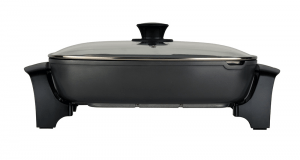
14 May Splints and Thermoplastic
What is thermoplastic and why do we use it?
If you’ve been to one of our clinics, you may have wondered why we have electric frying pans lying around. While they’re traditionally used for cooking food, at Melbourne Hand Rehab we use them to heat thermoplastic sheets which can then be used to make customised splints! When the unmoulded thermoplastic material is placed in hot water (usually 60o-70o C) it softens and becomes pliable. The softened material can then be perfectly moulded to support someone’s wrist, hand or finger.

When might you need a splint?
Certain injuries/conditions require complete or partial rest of the tendons, ligaments, joints, muscles or connective tissue around the hand. Splinting is a great way to restrict movement in the specific areas that need to be rested whilst allowing movement in unaffected body parts. Some conditions that are commonly splinted include De Quervain’s tenosynovitis, various wrist strains, sprains and tendinopathies, trigger finger, mallet finger and various fractures.
Main benefits to using thermoplastic materials:
It can be quickly moulded to your finger, hand or wrist and remoulded to suit your needs:
The material takes less than a minute to heat up and hardens again within 2-3 minutes. This property makes splint creation a quick process that we can easily fit into our appointments. Many people require splinting when their hand and wrist is in an inflamed state. In many cases, swelling subsides and splints may start to feel loose and unsupportive. One of the thermoplastic material’s useful properties is the ability to be remoulded with ease, which eliminates the need for an entire new splint or cast to be made.
Thermoplastic splints are often more comfortable and convenient to wear compared to other splints or casts:
Some studies have shown that people who use splints made from thermoplastic experience greater comfort compared to aluminium and other pre-made splints. It is also much lighter than plaster or fiberglass casts. Having a comfortable splint has been found to result in better compliance from splint wearers, which is likely to result in better outcomes from your treatment. As an added bonus, the material is waterproof which means you can enjoy showers and aquatic activities without having to worry about damaging your splint.
Thermoplastic is strong enough to provide a high level of support to the structures within the hand:
Studies of thermoplastic splint strength have shown that the material is strong enough to provide adequate support to many structures within the hand and wrist when compared to plaster or fibreglass casts. This makes it both practical and convenient for meeting your needs.
Bonus benefits:
They come in a range of stylish colours:
We offer a range of different coloured thermoplastic and straps when creating your splint. It gives you the option to turn your splint into a cool fashion accessory!
Thermoplastic can be washed if it gets dirty:
As opposed to plaster, which is notorious for getting dirty, thermoplastic splints can be washed (as long as you use cold water!)
By Rigel Mascarenhas


